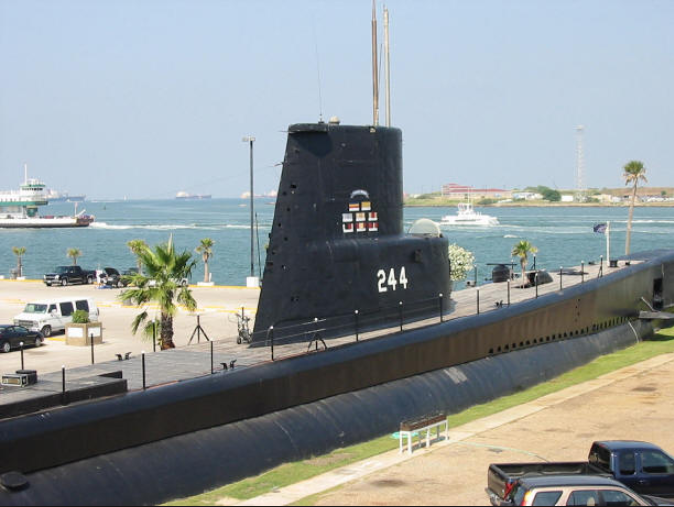Seawolf Park, located in historic Galveston, is a maritime tribute to one of the most overlooked groups of heroes in modern history: the brave submariners of World War II. This small fleet of underwater vessels and the courageous men who manned them were instrumental in winning WWII. Although they accounted for only two percent of the U.S. Navy, they sank an astounding 30 percent of the Japanese fleet.
The cost in lives was high, however, and over the course of the war, the Navy lost 52 submarines and well over 3,000 men. In fact, the submarine force had the highest losses of any division in the military during World War II. In gratitude for this sacrifice, Congress decreed that each state should create a memorial park to commemorate one of these lost subs and the men who gave their lives while serving on them. Seawolf Park is one such park.
Remembering the USS Seawolf
USS Seawolf was launched in 1939 and carried a crew of 83. She served with distinction until her loss, garnering 13 battle stars and sinking some eighteen ships over the course of the war. Seawolf, along with submarines Rasher and Trigger, ranked seventh in total ships sunk. In late 1944, she disappeared without a trace –although not as the result of an enemy attack. A subsequent investigation concluded that she had probably been sunk by friendly fire from the destroyer escort ship USS Rowell, a tragic ending for a crew who, along with their fellow submariners, played a large part in winning the war.
When she sank, Seawolf carried 83 submariners and an additional 17 Army passengers. All were lost, and neither the sub herself or any of her crew or passengers have ever been recovered. Seawolf Park stands as a memorial to these men and their service.
Although Seawolf herself lies somewhere at the bottom of the Pacific, Seawolf Park does feature a submarine of the same era: the USS Cavalla. This submarine served from 1943 through the end of the war and beyond, and was finally decommissioned in 1969. Today, she is listed on the National Register of Historic Places and gives visitors to Seawolf Park an idea of what life might have been like for the submariners aboard the ill-fated USS Seawolf.
Other histories at Seawolf Park
Seawolf Park is also home to the USS Stewart, an Edsall-class destroyer escort. She is one of only two surviving ships in her class, and one of only two preserved U.S. destroyer escorts – ships which were designed to hunt down and destroy submarines and to protect merchant ships from submarine attack. Stewart is a piece of Texas’ own history, having been built in Houston in 1942 and moved to Galveston in 1943 before actively beginning her naval career.
The Stewart spent the war protecting merchant ships from enemy submarines but was put in reserve shortly after the war. She was decommissioned in 1972 and donated to the city of Galveston in 1974. In 2006, she and the Cavalla underwent significant restoration. Today, she stands proudly at the end of Pelican Island, a monument to those who served their country both upon and under the sea during wartime.
The wreck of the USS Selma can be seen from Seawolf Park’s fishing pier. She is an example of an extremely rare type of naval craft – the concrete ship. Both world wars created steel shortages, which led shipbuilders to experiment with building ships of concrete rather than metal. During WWI, 24 such ships were commissioned, though only 12 were actually built. With the advent of WWII, concrete ships were once again constructed and played an important role in the war, including the D-Day invasion.
Selma herself is a WWI-era vessel, and the largest concrete ship ever built. She was launched on the day the Great War ended and never saw wartime service. Instead, she was used as an oil tanker. Her career lasted less than a year, though, for in 1920 she hit a pier and ripped a hole in her hull which proved impossible to repair. In 1922, she was intentionally scuttled and sits now just off the eastern shoreline of Pelican Island.
Seawolf Park, unlike any other maritime museum, contains all three components of WWII at sea: hunter, hunted, and protected – destroyer, submarine, and a merchant ship. In addition to these three ships of the World Wars, it also preserves the conning tower of the submarine USS Carp and the sail of the nuclear attack sub USS Tautog.
Mitchell Historic Properties, a privately owned and operated company based in Galveston Island, is proud to contribute to the history and historical significance of Galveston. Mitchell Historic Properties salutes the men who served aboard all these ships and is proud to contribute to the preservation of their memory. If you like this area and would like to live in the area or rent some space for your business please contact us.
Image Credit: www.cavalla.org


